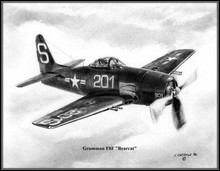 Loading... Please wait...
Loading... Please wait...- Home
- Combat Aircraft/Pencil Drawings ~ Free Shipping
- Grumman F8F "Bearcat" ~ Free Shipping
Product Description
Print Size 8½" x 11" ----- Unlimited print edition
The F8F prototypes were ordered in November 1943 and first flew on 21 August 1944, a mere nine months later. The first production aircraft was delivered in February 1945 and the first squadron was operational by 21 May, but World War II was over before the aircraft saw combat service. Postwar, the F8F became a major US Navy fighter, equipping 24 fighter squadrons. Often mentioned as one of the best (if not the best) handling piston-engine fighters ever built, their performance was such that they even outperformed many early jets. Its capability for aerobatic performance is borne out by the choice of the Bearcat for the Navy's elite Blue Angels in 1946, who flew it until the team was temporarily disbanded in 1950 (during the Korean War). The Grumman F9F Panther and McDonnell F2H Banshee largely replaced the Bearcat in USN service, as their performance and other advantages eclipsed piston-engine fighters. An unmodified production F8F-1 set a 1946 time-to-climb record (after a run of 115 feet) of 10,000 feet in 94 seconds. The Bearcat held this record for ten years until it was broken by a modern jet fighter (which could still not match the Bearcat's short takeoff distance). Other nations that flew the Bearcat included the French and Thai air forces. French aircraft saw combat service in the First Indochina War as fighter-bombers in the early 1950s.
Warranty Information
null








